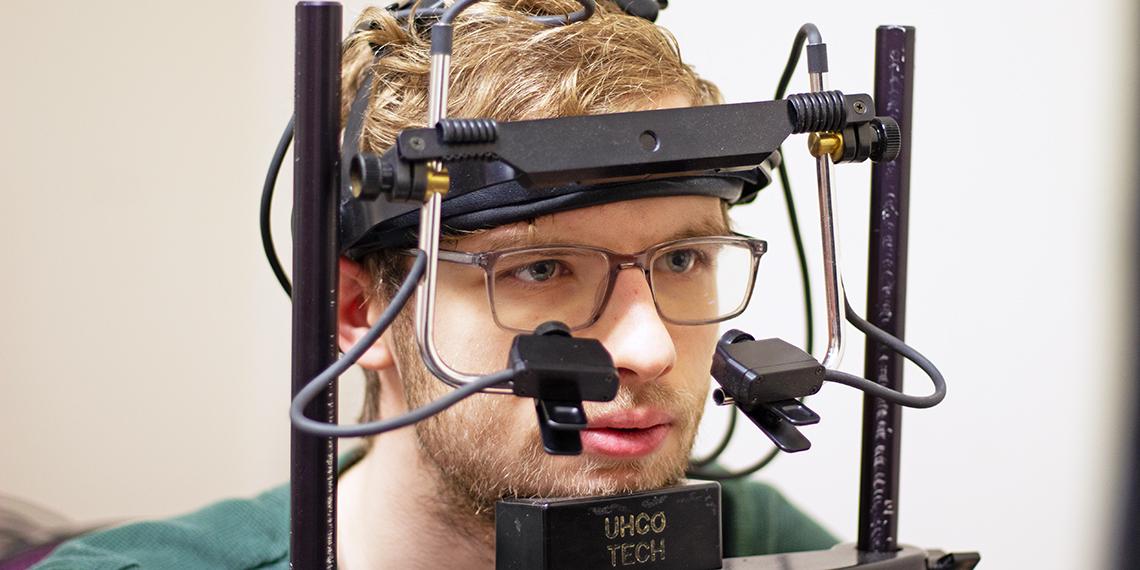Eyes as a Window to the Brain

A quiet, dimly lit room is not the sort of setting one would envision for testing the effect of distractions on the human brain. However, this is exactly what Dr. Mazyar Fallah and his team in the Department of Human Health and Nutritional Sciences are doing.
Understanding the human brain and how it perceives the world is no easy task. One cannot simply look inside to see what’s going on. This is why external cues are used to measure internal brain processes. For Fallah and his team, they use eye movements of participants to “see” into the brain.
“Your eyes really are a window into the brain,” says Fallah. “Eye movements reflect a lot of different cognitive functions and processes.”
Using sophisticated eye tracking technology, the team measures eye movement in a carefully controlled setting as a way of understanding how the brain processes visual stimuli as it “decides” how the body will move in response.
“Through eye movements, we can see where attention is being focused, and thus what objects are driving cognitive attention to that location,” explains Dr. Heather Jordan, a senior research associate in the Fallah lab.
Focusing on specific targets with our eyes while ignoring irrelevant ones – called “distractors” – is something most of us do every day without conscious thought. However, it actually involves many different systems within the brain. For example, focusing on the correct target can depend on its relative position to us in physical space, called the “egocentric” reference frame. It can also depend on the target’s relative position to other objects in the space, called the “allocentric” reference frame.
Fallah uses a common scenario to illustrate this concept. “If you're out with friends at a bar, and you all have a mug of beer on the table, your mug of beer is closer to you, and this is coded egocentrically. If you get up and move to the other side of the table, all the mugs of beer are in the same place, but yours is no longer the one closest to you. However, you still know which one is yours relative to everyone else’s, and this is encoded allocentrically. This means that you can identify your mug as the target object and the other mugs as distractors. This helps with planning your movements to grab the correct mug while avoiding the others on the table.”
 In a recent study published in Scientific Reports, the team found that our eye movements and attention toward or away from distractor objects are influenced by both decision-making time and the spatial relationship of objects relative to both the observer and each other.
In a recent study published in Scientific Reports, the team found that our eye movements and attention toward or away from distractor objects are influenced by both decision-making time and the spatial relationship of objects relative to both the observer and each other.
In the first couple of hundred milliseconds of visual processing, objects that are closer to you will draw your attention most strongly. However, once your brain has clearly identified the desired target, it then suppresses attention towards the distractors, and the strength of that suppression is based on the distance between the target and distractors. In other words, early attention is driven by how close an object is to your point of gaze, but once a decision has been made, distractors are supressed relative to the target itself, enhancing focus on the target.
The findings have broad-reaching applications. For example, it could aid first responders in finding survivors of wildfires. Through augmented reality, wearable eye-tracking systems can be created that flag regions of vision that have been missed and indicate where to look again.
Another potential application is the use of eye movements to diagnose certain neurodegenerative diseases. Since eye tracking is more accessible than an MRI, it opens up exciting new opportunities within a clinical setting.
Fallah notes that the lead author of the study, Coleman Olenick, was an undergraduate researcher, and he encourages all undergraduates to explore their interests through summer research assistantships and/or fourth-year project courses.
“Dream big! When you get an opportunity, make the most of it,” says Fallah.
And for anyone who is simply keen to learn a bit more about the fascinating world of eye movements and cognitive function, the Fallah lab is always looking for study participants, so you too can lend your brain to further this research.
This research was funded by that Natural Sciences and Engineering Research Council.
Read the full study in the journal Scientific Reports.
Read about other CBS Research Highlights.